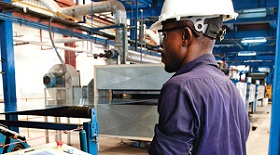Kenya pursuing manufacturing growth
Posted on : Friday , 16th January 2015

Kenya’s government is currently considering the final iteration of a bill that would establish three special
economic zones (SEZs) within the country. The SEZs will allow lower levels of taxation and fewer regulatory hurdles, and will focus primarily on industrial activity, in particular textile production. The SEZ bill is part of a broader initiative to boost the manufacturing sector, diversify the country’s exports and encourage the creation of up to 1m industrial jobs annually. The law establishing the SEZs is expected to be passed by parliament by the end of June. In addition to providing land, tax holidays, duty-free imports and waivers on value-added tax to potential clients, the government is hoping the zones will directly create 10m jobs over the next 30 years. The SEZs are planned for Mombasa, where 2000 sq km of land has already been set aside, the Indian Ocean port city of Lamu, and the western city of Kimusu, near Lake Victoria. The Cabinet Secretary for Industrialisation and Enterprise Development, Adan Mohamed, also announced in February that the zones would specifically target foreign textile firms, with a view to enticing producers from the textile industries in Myanmar, China, Vietnam and South Africa. Mohamed has estimated that two to three additional years will be required before the zones can be marketed to investors. In addition to a single free trade zone in Mombasa, Kenya has established Export Processing Zones (EPZs), which contributed $543m to the Kenyan economy in 2013. EPZ Authority CEO Cyrille Nabutola has said that EPZs account for
roughly 10% of Kenya’s total exports – the bulk of which are textiles and apparel sent to the US – as well as 3.2% of GDP. As of 2012, garment manufacturers accounted for 29% of EPZ companies, 56% of EPZ exports and 30% of EPZ private investments If the high input costs can be reduced, there is plenty of potential for expansion in a wide range of segments.
Textiles offer particularly strong potential for growth, despite the competitive global market, in part due to strong regional demand and accessible inputs. Currently, textile manufacturing accounts for around 4% of Kenya’s manufacturing industry. In an interview with OBG, Mohamed said, “We have a massive amount of arable land perfect for cotton, but it is not being done today for a number of reasons, mostly historical. Textiles alone have the capacity to employ 1m more people, but we currently produce less than 10% of our potential capacity.” Textile exports have benefitted from the Africa Growth and Opportunity Act preferential trade agreement with the US, which expires in 2015, with an extension currently being discussed. Textile exports to the US grew by 18.2% between 2011 and 2013, from $261.29m to $308.93m. According to Nabutola, Kenya surpassed Lesotho in 2013 to become Africa’s biggest textile exporter to the US. Textile production is extremely competitive and the end of the multi-fibre accords have seen a drop in trade from former large producers elsewhere in Africa, but given
how job-intensive garment manufacturing can be, if the government succeeds in luring foreign textile firms through lower production costs, turnkey infrastructure and tax breaks, the broader benefits of initiatives like the SEZs could be significant.
Source : dl.dropboxusercontent.com


